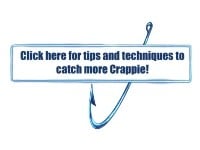I thought an article on fishing rod handles would be so easy. Seriously, just how many styles and materials can rear grips, foregrips, butt caps and reel seats can there be? Apparently, from a quick search on Google hundreds of them, however, before it becomes overwhelming, I enlisted the help from experts to educate us on fishing rod handles.
“Two things that come to my mind when you are talking about crappie fishing rod handles is personal preference and cost. You’re just not going to find many crappie anglers fishing with super expensive fishing rods, however, they are still going to find the best price, lightweight and most sensitive rod they can afford. Another thing that’s important to know when selecting a fishing rod is how deep is the crappie angler going to be fishing. If an angler is fishing shallow and just dipping lures or minnows than an underspin style fishing rod is better, however, if the same angler is fishing deep say in ten foot of water or deeper than a fishing rod that can fit a spinning reel or baitcasting reel is better,” said B’n’M Poles Pro Staff Manager Kent Driscoll.
EVA (ethylene-vinyl acetate) foam or cork is normally the materials used to make rear grips and foregrips. “Cork is lighter than EVA foam and I believe more sensitive than EVA foam. But, cork is stickier, so you get a better grip than foam. Again it’s a personal preference on which material,” said Driscoll.
Butt material is often overlooked when it comes to selecting a rod for crappie fishing. Butt grip material is commonly made from plastic, rubber, cork or cork composite. EVA foam with straight or split grip handle made from EVA foam or cork. Most are durable and lightweight, but if made from rubber may grab clothing when setting out lines, setting the hook or fighting the fish.
Shapes of the butt end usually is round ball, conical, collared or even just have a reel seat and no butt end. Round ball butt end is comfortable when pressed against the body or arm. Conical is normally tapered, but less comfortable when press against the body. “B’n’M Poles Pow-R-Troller has a specially designed rear mounted rod collar to allow easy fit and secure it into the rod holder; without the collar a rod holder will put a dent in the foam or even wear a hole in the foam,” said Driscoll.
How of butt length do you need? Butt lengths vary from less than 4-inch to over 12-inches or more. Anything less than 5-inches and you won’t get much leverage when holding or setting the hook. From 5- to 10-inches is still good for casting. The best length for leverage and to be able to steer the rod is over 10-inches.
Crappie rods will have a fixed reel seat or Tennessee Handle style like the B’n’M Poles Sharpshooter (www.bnmpoles.com) made from cork or EVA foam with sliding rings to put the reel anywhere on the handle. Another style is a rod with no guides or eyes and has a line thru the blank design where the reel is built into the rod blank. “Line thru blanks like the Cadillac Combo or Whitey Outlaw Santee Elite fishing rods are great for poking lures into cover or around docks,” said Driscoll.
Lake of the Ozark fishing guide Terry Blankenship (www.terryblankenship.com) targets crappie around the numerous boat docks and brush piles around the lake. “I’m using the rod to present the lure so the crappie will bite it. If you shoot docks or fish deep water brush piles you know what I mean; it’s important to combine the right fishing rod, lure and jighead,” said Blankenship.
When shooting docks, Blankenship uses a 7-foot spinning rod paired with a spinning reel. “I like a long rod handle that fits under you arm allowing it to stabilizing the rod. I get a more accurate cast with the longer rod and rod handle. I’m not a fan of the Tennessee style handle, I just don’t trust them to keep the reel in place on the rod handle,” said Blankenship.
When shooting docks, Blankenship likes to match the hatch and his favorite lure is a Bobby Garland Crappie Baits (www.bobbygarlandcrappie.com) 2 ¼-inch Baby Shad Swim’R rigged on a Bobby Garland Crappie Baits jighead. Other lures Blankenship uses is the 3- or 2-inch Slab Slay’R.
To fish vertically in the deep brush piles, Blankenship uses a medium light 6- to 6-10 spinning rod with a medium length rod handle and spinning reel. “I’m constantly casting and reeling when fishing brush piles. I like a 2-inch Baby Shad with 1/16-ounce Mo Glo jighead when fishing deep or at night in brush piles. My favorite colors of Baby Shad are Monkey Milk, Electric Chicken and Bluegrass,” said Blankenship.
In the end, which fishing rod handle is best comes to personal preference and what a crappie angler is willing to spend on a fishing rod.




 Articles and Stories
Articles and Stories

















vBulletin Message